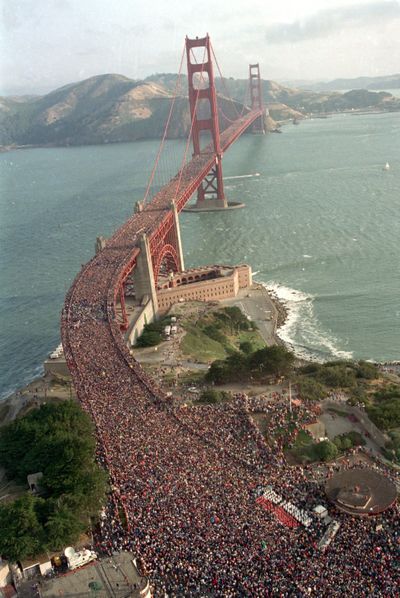Golden Gate enjoys diamond anniversary with help of engineers

SAN FRANCISCO – The Golden Gate Bridge was heralded as an engineering marvel when it opened in 1937. It was the world’s longest suspension span and had been built across a strait that critics said was too treacherous to be bridged.
But as the iconic span marks its 75th anniversary this weekend, the generations of engineers who have overseen it all these years say keeping it up and open has been something of a marvel unto itself.
Crews had to install a bracing system after high winds lashed and twisted the span in the 1950s, raising fears it would collapse. Years later, they had to replace vertical cables when they were found to have corroded in the bridge’s damp, foggy climate, potentially destabilizing the span. The bridge, which rises majestically above a Civil War era fort on the San Francisco side and arches across to the Marin County headlands on the north side, is currently in the midst of a seismic upgrade that has seen many of its key structures replaced or modified. Plans for a moveable barrier to separate north and southbound traffic and a net system to prevent suicides are also moving forward.
“When (one of the bridge’s designers) made his final speech during opening day ceremonies in 1937, he said, ‘I present to you a bridge that will last forever,’ ” said Daniel Mohn, the bridge’s former chief engineer. “What he should have said is, ‘I present to you a bridge that will last forever if properly maintained.’ ”
The idea for a bridge across the Golden Gate strait, where San Francisco Bay meets the Pacific Ocean, was championed by the engineer Joseph Strauss in the 1920s. Strauss’ original design, submitted to San Francisco city officials in 1921, called for a hybrid cantilever-suspension bridge. The idea for a full-suspension span – the design that was ultimately built – came later.
At a little more than three-fourths of a mile in length, the Golden Gate Bridge would become the world’s longest suspension span. It had to be light enough to hang from its own cables, but still strong enough to withstand the strait’s fierce winds and the possibility of earthquakes. Some said it was impossible. Engineers also had to calculate all the potential forces on the bridge without the help of computers.
“In those days, you had (notebooks) and a No. 2 pencil and you wrote it out, did all the math at your desk,” said Kevin Starr, a history professor at the University of Southern California, who has also written about the bridge.
Eleven men died during construction from 1933 to 1937 – 10 of them when scaffolding fell through a safety net that had been set up to protect workers. The conditions were difficult, cold, foggy and windy, and workers who helped construct supports for the south tower had to contend with dangerous tides.
But it was the wind that would continue to vex engineers years after the bridge’s completion. In 1951, it was closed for several hours when wind gusts approached 70 mph and caused the bridge to flutter. It was twisting so badly, Mohn recalled during a recent phone interview, that the light standards at the center of the span were striking the main cables.
“It sure almost destroyed the Golden Gate Bridge,” he said. The Tacoma Narrows Bridge in Washington – a suspension bridge whose designer also worked on the Golden Gate – had twisted and snapped in about 40 mph winds a little more than a decade earlier. That 1940 collapse was captured on film.
Although the Golden Gate Bridge had stiffening trusses that made it less susceptible to wind, it did sustain damage, Mohn said. Officials decided to add lateral bracing that made the trusses more stable and reduced the chances of the bridge going into a potentially catastrophic twisting motion.
The bridge would be able to withstand winds of 70 mph today although the goal is to eventually increase its tolerance to 100 mph, according to Ewa Bauer, the bridge’s current chief engineer.
The wind is not the only element to take its toll on the span. The damp, foggy air has also kept its painters and engineers busy.
“You couldn’t have put the bridge in a more corrosive atmosphere than in the middle of the Golden Gate with that salt fog coming in,” Mohn said. Today, among the engineers’ most pressing concerns is the potential effect of a major earthquake.
The 1989 Loma Prieta earthquake caused two 50-foot sections of the San Francisco-Oakland Bay Bridge to collapse.
The Golden Gate Bridge was not damaged. But the quake still spurred bridge officials to undertake a massive retrofit of the span – a $660 million project that began in 1997 and is still under way. The bridge, like other infrastructure, has a lifespan. But Bauer and Mohn say with proper maintenance, the Golden Gate Bridge will endure. The retrofit project alone will buy the span another 150 years, Bauer estimated.
“I believe the bridge was built to absolute great standards of workmanship,” she said on a recent morning at a vista point overlooking the span. “What we are doing right now is repairing … and you can truly do it indefinitely.”